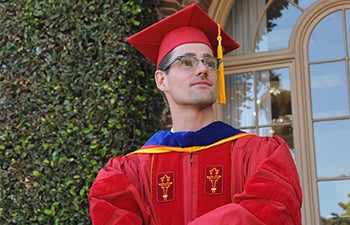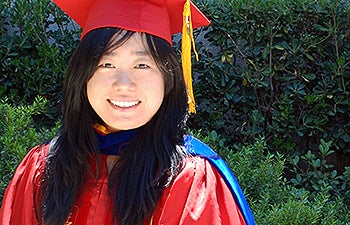Our Dazzling Doctorates
Jia Liu: Dancing Through Darkness
At age 6, Jia Liu was preparing for her first televised performance with an elite dancing school in Inner Mongolia. As a reward for her success, her grandparents offered to take her to dinner. Before they left, she went outside to play.
Her home stood near train tracks.
“All I felt was black in front of my eyes; that’s the last thing I can remember before waking up in the hospital,” said Liu, who was hit by a train.
Liu lost her leg — and also her dream.
“It was a terrible moment when I realized that I couldn’t do what I thought I was born to do,” said Liu, who earned her Ph.D. in chemistry and was hooded during the May 15 ceremony.
Liu spent the following year in the hospital undergoing surgeries and being fitted with a prosthetic leg, which she described as technologically inadequate. “I couldn’t walk at all,” said Liu.
Once home, she hardly left her room.
It took about a year for her to tap into her innate resilience.
“I think being young helped me adapt to the new situation,” she said. “I never realized that being able to walk was such a precious thing. I felt so hopeless after, but looking back it was really a gift.”
Liu’s mother introducing her to a group for people with disabilities became her turning point. “Hearing their stories, I realized that other children had been blind their whole lives, and some of their disabilities were so much worse than mine,” she said.
At age 10, Liu began writing for a local newspaper and TV station about her experience. She also reported on issues relating to children and teenagers.
Immediately after she could walk with her prosthesis, she started dancing again — first in a group for children with disabilities and eventually with a regular troupe. At 13, Liu was among 20 performers of all ages chosen to travel to Taiwan and perform traditional Mongolian dance.
For high school, Liu earned a scholarship to attend United World College, an English-language International Baccalaureate program in Norway that selects students from 83 countries. She was the only teenager in all of China — Inner Mongolia is a region of China — chosen to participate.
Although her first academic passion was writing, Liu’s English was not strong enough for her to concentrate in literature. She turned to less language-heavy subjects and selected economics and the natural sciences.
In 2005, she received scholarships to study at Westminster College in Missouri, where she majored in physics and chemistry. Following her sophomore year, she interned at the Fermilab in Chicago, Ill. working on high-energy physics. After her junior year, she completed another internship at Washington University in St. Louis in a nuclear chemistry laboratory.
In 2009, Liu visited USC, where she met professor Chongwu Zhou of USC Viterbi School of Engineering.
“I was just fascinated by his research,” she said. “He works on nanotechnology to develop the next generation of electronics. Imagine the transparent, almost-floating computers people have in the movies.”
She enrolled in USC Dornsife and began working in Zhou’s laboratory.
Zhou and Liu published their groundbreaking research in the journal Nature Communication. Their research describes a method to control the structure of carbon nanotubes using a furnace set at 900 degrees. Carbon nanotubes have many application possibilities, but scientists have found difficulty precisely controlling its geometry.
“Our research has the potential to make computers use less energy but be faster and more powerful,” she said. Moving forward, she wants to work in the technology industry.
Liu attributes much of her success to her early struggles and everyone who has helped and supported her.
“Sometimes I look back and think my life is like a movie,” she said. “So many people have told me that they heard my story, and that it gave them hope. I am lucky to have had so many different passions, and when you are doing something you’re passionate about, it never feels like work.”
—L.H.
The 2013 Ph.D. Hooding Ceremony took place May 15 at the USC University Park campus, where 203 Dornsife doctoral degrees were issued. During the event, USC Dornsife Dean Steve Kay spoke to graduates. Photos by Matt Meindl.
Ben Parrell: To Infinity and Beyond

Ben Parrell. Photo by Pamela J. Johnson.
There is a small opening in the ensÃ…Â — a circle emblem of Zen Buddhism — tattooed on the inside of Ben Parrell’s right forearm. Encircled with one broad imperfect brushstroke, the opening shows that the ensÃ…Â is not contained in itself, but opens out to infinity.
“It reminds me every day that while there is a beginning and an end to everything, our lives are continuous,” Parrell said. “There will be more beginnings and ends.”
Parrell concluded his academic career at USC Dornsife May 15, when he earned his Ph.D. in linguistics. His new beginnings come in the form of two job offers.
In August, he begins a one-year postdoctoral research post at the University of California, Berkeley’s Department of Psychology. After that, he has secured a tenure-track position at the University of Delaware’s Department of Linguistics and Cognitive Science.
Born and raised in Madison, Wis., Parrell had planned to become an architect. Earning his bachelor’s in Spanish at the University of Oregon, he started a master’s program in architecture at the same university.
“I wasn’t in love with it,” he said of architecture. He felt more connected to languages. “The more linguists’ classes I was exposed to, the more I liked the field.”
He took a two-year break from school, working in an architecture firm in Chicago, Ill., then as a visiting academic under professor Joaquín Romero at the Universitat Rovira i Virgili in Tarragona, Spain.
Languages won out. After Romero encouraged him to apply to USC Dornsife’s linguistics graduate program, Parrell worked as a research assistant for Dani Byrd, professor of linguistics and vice dean for institutional affairs, and has conducted research with linguistics professor Louis Goldstein. With Byrd, he participated in a National Institutes of Health-funded project on the prosody and articulatory dynamics in spoken language.
Parrell’s research examines the relationship between cognitive linguistic representation and movements of the lips, tongue, and jaw during speech. For instance, he examines the articulatory control of stops in Spanish and English. In phonetics, a stop is a sound (consonant) made by blocking the airflow then releasing it. In English, the stops, voiceless and voiced, can be p, t, k, b, d and g. In his studies, he uses a variety of tools, including real-time magnetic resonance imaging (MRI).
His postdoctoral research will investigate the role of the cerebellum in speech movement and motor speech disorders such as dysarthria — when the muscles of the mouth, face and respiratory move slowly after a stroke or brain injury. Ultimately, he’s interested in how the speech system may break down and what such breakdowns can tell us about healthy speech.
“I’m looking forward to getting students excited about speech,” said Parrell, who also coached the men’s ultimate Frisbee team at USC. “Speaking is one of the most fundamental things we do as humans, yet there is still so much that we don’t yet understand about this amazingly complex behavior.”
—P.J.J.
